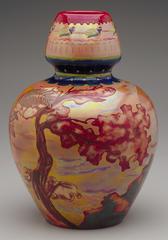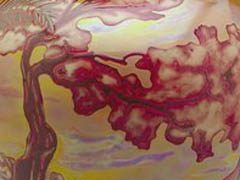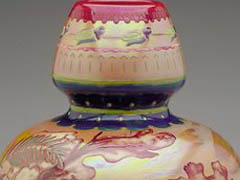
 |
 This vase combines popular folk art MOTIFS, which look back to the roots of the Hungarian (Magyar) people, with the flowing plant and animal forms called Art Nouveau (New Art). The continuous scene on the sides and mouth blend these two influences. Abstracted tree branches spread across a vibrant purple and gold sky.
This vase combines popular folk art MOTIFS, which look back to the roots of the Hungarian (Magyar) people, with the flowing plant and animal forms called Art Nouveau (New Art). The continuous scene on the sides and mouth blend these two influences. Abstracted tree branches spread across a vibrant purple and gold sky.
Flying birds encircle the mouth of the vessel. They have been STYLIZED as rounded, streamlined shapes of head, wings, and body represented by a few BRUSHSTROKES of blue and green glazes. The birds are similar to ones found embroidered on aprons and other garments worn by peasant women in remote Hungarian villages at the time the vase was made. Artists recorded and studied such motifs from native hand-crafts in a search for continuity with Hungary's past.
 |
Art Nouveau came later to Hungary than to the rest of Europe but found fertile ground there. It blended easily with a centuries-old tradition of carved and decorated houses, heavily embroidered clothing, and highly decorative articles for everyday use. As industry grew and modern cities sprang up, the people of Hungary became more interested in old themes in hand-crafts that represented a simpler time in Hungarian life. In fact the promotion of folk art was a form of criticism of modern city life. |
Key ideas.
Where does it come from?
What does it look like?
How was it used?
How was it made?
How big is it?
Who Knows?
Additional resources.
